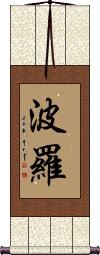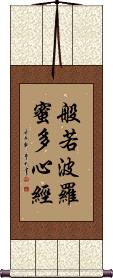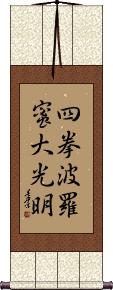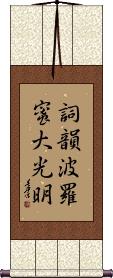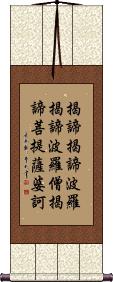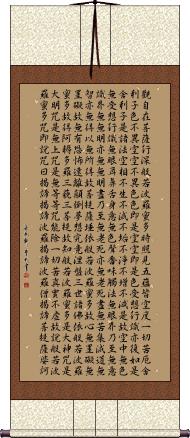Many custom options...
And formats...

波羅 in Chinese / Japanese...
Buy an 波羅 calligraphy wall scroll here!
Personalize your custom “波羅” project by clicking the button next to your favorite “波羅” title below...
Pollo
Polo
This is a common way to write Polo in Chinese.
This would also be the way to write Polo for the surname or the car made by Volkswagen (the Polo model is sold worldwide with the exception of the USA). It can also refer to Marco Polo in Chinese.
In Japanese, this is a name that romanizes as Hara.
Apollo
Apollon
Marco Polo
Paramartha
波羅末陀 is the Chinese and Japanese way to write the ancient Sanskrit word Paramārtha or परमार्थ which now means the highest truth, ultimate truth, ultimate reality, or fundamental meaning.
Paramārtha is the name of a famous Buddhist monk born in 499 CE. Paramārtha traveled the world (including Cambodia and territories that are now part of China) to spread the teachings of Buddhism by translating scriptures into the local languages so the truth could be understood by the masses.
So, we should all want to be a Paramārtha who brings the ultimate truth, knowledge, and enlightenment to others.
Heart Sutra Title
Shiken Haramitsu Daikomyo
四拳波羅蜜大光明 is “shiken haramitsu daikōmyō,” a famous Japanese Buddhist mantra.
四拳 = shi-ken = four fists (many translate this as “four hearts”).
波羅蜜 = ha-ra-mitsu = A loanword representing pāramitā, or entrance into Nirvana. Awkwardly, it also means jackfruit.
大光明 = dai-kou-myo = big/great light bright (great bright light).
Shiken represents four hearts:
1. The Merciful Heart - Love and caring for all living things.
2. The Sincere Heart - Pursues righteousness, or the right path - sincerely trying to do what is right.
3. The Attuned Heart - Knows that nature and fate have their ways, and thus stay in tune with the universe.
4. The Dedicated Heart - Steadfast on the chosen path to the end.
Shikin Haramitsu Daikomyo
詞韻波羅蜜大光明 are the Japanese Kanji characters that romanize as “Shikin Haramitsu Daikōmyō.”
This is a complicated proverb. I'm actually going to forgo writing any translation information here. You can figure it out via Google search and at sites like Paramita and the Perfection of Wisdom or
Fecastel.Wordpress.com::Shikin Haramitsu Daikōmyō
Heart Sutra Mantra
Heart Sutra
This is the Heart Sutra in Chinese as translated by Xuanzang.
The Heart Sutra is often cited as the best-known and most popular of all Buddhist scriptures.
Notes: There are too many characters for this to be done by the economy calligrapher. You must choose a Master Calligrapher.
With this many characters, and the fact that one tiny mistake wipes out hours of work, keep in mind that writing the Heart Sutra is usually a full day of work for a calligrapher. This work and personal energy should be cherished and respected. In other words, the calligrapher is not charging enough money for the value that you are getting here.
Also, you will find that as my server processes 260 characters, the customization process is a bit slow for this title.
Not the results for 波羅 that you were looking for?
Below are some entries from our dictionary that may match your 波羅 search...
| Characters If shown, 2nd row is Simp. Chinese |
Pronunciation Romanization |
Simple Dictionary Definition |
波羅 波罗 see styles |
bō luó bo1 luo2 po lo hara はら |
More info & calligraphy: Polo(surname) Hara fool |
阿波羅 阿波罗 see styles |
ā bō luó a1 bo1 luo2 a po lo |
More info & calligraphy: Apollon |
波羅末陀 波罗末陀 see styles |
bō luó mò tuó bo1 luo2 mo4 tuo2 po lo mo t`o po lo mo to haramada |
More info & calligraphy: Paramartha |
馬可波羅 马可波罗 see styles |
mǎ kě bō luó ma3 ke3 bo1 luo2 ma k`o po lo ma ko po lo |
More info & calligraphy: Marco Polo |
伏波羅 see styles |
fushihara ふしはら |
(place-name) Fushihara |
六波羅 see styles |
rokuhara ろくはら |
(surname) Rokuhara |
劫波羅 劫波罗 see styles |
jié bō luó jie2 bo1 luo2 chieh po lo kōhara |
kapāla, a skull; also kārpāsa, see劫波娑. |
奥波羅 see styles |
okuhara おくはら |
(surname) Okuhara |
密波羅 see styles |
mitsuhara みつはら |
(surname) Mitsuhara |
尼波羅 尼波罗 see styles |
ní bō luó ni2 bo1 luo2 ni po lo Nihara |
Nepala, Nepal, anciently corresponding to that part of Nepal which lies east of the Kathmandu. Eitel. |
波波羅 波波罗 see styles |
bō bō luó bo1 bo1 luo2 po po lo hahara |
Pippala, ficus religiosa. |
波羅伽 波罗伽 see styles |
bō luó qié bo1 luo2 qie2 po lo ch`ieh po lo chieh haraka |
pāraka, carrying over, saving; the pāramitā boat. |
波羅夷 波罗夷 see styles |
bō luó yí bo1 luo2 yi2 po lo i harai はらい |
{Buddh} parajika (rules entailing expulsion from the sangha for life) pārājika. The first section of the Vinaya piṭaka containing rules of expulsion from the order, for unpardonable sin. Also 波羅闍巳迦; 波羅市迦. Cf. 四波羅夷. There are in Hīnayāna eight sins for expulsion of nuns, and in Mahāyāna ten. The esoteric sects have their own rules. |
波羅奈 波罗奈 see styles |
bō luó nài bo1 luo2 nai4 po lo nai Harana |
(波羅奈斯) Vārāṇasī. Ancient kingdom and city on the Ganges, now Benares, where was the Mṛgadāva park. Also 波羅捺 (波羅捺寫); 波羅痆斯; 波刺那斯. |
波羅密 see styles |
haramitsu はらみつ |
(surname) Haramitsu |
波羅柰 波罗柰 see styles |
bō luó nài bo1 luo2 nai4 po lo nai Harana |
Vārāṇasī |
波羅的 波罗的 see styles |
bō luó dì bo1 luo2 di4 po lo ti |
Baltic |
波羅羅 波罗罗 see styles |
bō luó luó bo1 luo2 luo2 po lo lo harara |
bignonia suaveolens |
波羅蜜 波罗蜜 see styles |
bō luó mì bo1 luo2 mi4 po lo mi haramitsu はらみつ |
jackfruit; breadfruit; Artocarpus heterophyllus (1) (はらみつ only) {Buddh} (See 波羅蜜多) pāramitā; perfection; perfection of Buddhist practices or attaining enlightenment; (2) (kana only) jackfruit (Artocarpus heterophyllus); (surname) Haramitsu pāramitā |
波羅赴 波罗赴 see styles |
bō luó fù bo1 luo2 fu4 po lo fu Harafu |
Prabhu, 鉢唎部 surpassing, powerful; a title of Viṣṇu 'as personification of the sun', of Brahmā, Śiva, Indra, etc. prabhū, come into being, originate, original. |
波羅越 波罗越 see styles |
bō luó yuè bo1 luo2 yue4 po lo yüeh haraotsu |
Pārāvata, a dove; the fifth row of a rock-cut temple in the Deccan, said to resemble a dove, described by Faxian. |
波羅迦 波罗迦 see styles |
bō luó jiā bo1 luo2 jia1 po lo chia haraga |
Pāraga, a title of the Buddha who has reached the other shore. |
波羅門 波罗门 see styles |
bō luó mén bo1 luo2 men2 po lo men baramon |
Brahmin, v. 婆. |
畢波羅 毕波罗 see styles |
bì bō luó bi4 bo1 luo2 pi po lo Pippara |
Pippalāyāna |
瞿波羅 瞿波罗 see styles |
jù bō luó ju4 bo1 luo2 chü po lo Guhara |
Gopalā, name of a nāga-king, of a yakṣa, and an arhat. |
矢波羅 see styles |
yabara やばら |
(place-name) Yabara |
繁波羅 see styles |
hanbara はんばら |
(place-name) Hanbara |
蜜波羅 see styles |
mitsuhara みつはら |
(surname) Mitsuhara |
金波羅 金波罗 see styles |
jīn bō luó jin1 bo1 luo2 chin po lo konbara |
kumbhīra |
五波羅密 五波罗密 see styles |
wǔ bō luó mì wu3 bo1 luo2 mi4 wu po lo mi go haramitsu |
The five pāramitās (omitting the sixth, wisdom), i. e. dāna, almsgiving: śīla, commandment-keeping; kṣānti, patience (under provocation): vīrya, zeal; and dhyāna, meditation. |
Click here for more 波羅 results from our dictionary
The following table may be helpful for those studying Chinese or Japanese...
| Title | Characters | Romaji (Romanized Japanese) | Various forms of Romanized Chinese | |
| Pollo | 波羅 波罗 | bō luó / bo1 luo2 / bo luo / boluo | po lo / polo | |
| Polo | 波羅 波罗 | hara | bō luó / bo1 luo2 / bo luo / boluo | po lo / polo |
| Apollo | 阿波羅 阿波罗 | ā bō luó a1 bo1 luo2 a bo luo aboluo | a po lo apolo |
|
| Apollon | 阿波羅 阿波罗 | ā bō luó a1 bo1 luo2 a bo luo aboluo | a po lo apolo |
|
| Marco Polo | 馬可波羅 马可波罗 | mǎ kě bō luó ma3 ke3 bo1 luo2 ma ke bo luo makeboluo | ma k`o po lo makopolo ma ko po lo |
|
| Paramartha | 波羅末陀 波罗末陀 | ha ra ma da haramada | bō luó mò tuó bo1 luo2 mo4 tuo2 bo luo mo tuo boluomotuo | po lo mo t`o polomoto po lo mo to |
| Heart Sutra Title | 般若波羅蜜多心經 般若波罗蜜多心经 | bō rě bō luó mì duō xīn jīng bo1 re3 bo1 luo2 mi4 duo1 xin1 jing1 bo re bo luo mi duo xin jing boreboluomiduoxinjing | po je po lo mi to hsin ching pojepolomitohsinching |
|
| Shiken Haramitsu Daikomyo | 四拳波羅蜜大光明 | shi ken ha ra mitsu dai kou myou shi ken ha ra mitsu dai ko myo | ||
| Shikin Haramitsu Daikomyo | 詞韻波羅蜜大光明 词韵波罗蜜大光明 | shi kin ha ra mitsu dai kou myo shikinharamitsudaikoumyo shi kin ha ra mitsu dai ko myo | ||
| Heart Sutra Mantra | 揭諦揭諦波羅揭諦波羅僧揭諦菩提薩婆訶 揭谛揭谛波罗揭谛波罗僧揭谛菩提萨婆诃 | jiē dì jiē dì bō luō jiē dì bō luō sēng jiē dì pú tí sà pó hē jie1 di4 jie1 di4 bo1 luo1 jie1 di4 bo1 luo1 seng1 jie1 di4 pu2 ti2 sa4 po2 he1 jie di jie di bo luo jie di bo luo seng jie di pu ti sa po he | chieh ti chieh ti po lo chieh ti po lo seng chieh ti p`u t`i sa p`o ho chieh ti chieh ti po lo chieh ti po lo seng chieh ti pu ti sa po ho |
|
| Heart Sutra | 觀自在菩薩行深般若波羅蜜多時照見五蘊皆空度一切苦厄舍利子色不異空空不異色色即是空空即是色受想行識亦復如是舍利子是諸法空相不生不滅不垢不淨不增不減是故空中無色無受想行識無眼耳鼻舌身意無色聲香味觸法無眼界乃至無意識界無無明亦無無明盡乃至無老死亦無老死盡無苦集滅道無智亦無得以無所得故菩提薩埵依般若波羅蜜多故心無罣礙無罣礙故無有恐怖遠離顛倒夢想究竟涅盤三世諸佛依般若波羅蜜多故得阿耨多羅三藐三菩提故知般若波羅蜜多是大神咒是大明咒是無上咒是無等等咒能除一切苦真實不虛故說般若波羅蜜多咒即說咒曰揭諦揭諦波羅揭諦波羅僧揭諦菩提薩婆訶 观自在菩萨行深般若波罗蜜多时照见五蕴皆空度一切苦厄舍利子色不异空空不异色色即是空空即是色受想行识亦复如是舍利子是诸法空相不生不灭不垢不净不增不减是故空中无色无受想行识无眼耳鼻舌身意无色声香味触法无眼界乃至无意识界无无明亦无无明尽乃至无老死亦无老死尽无苦集滅道无智亦无得以无所得故菩提萨埵依般若波罗蜜多故心无罣碍无罣碍故无有恐怖远离颠倒梦想究竟涅盘三世诸佛依般若波罗蜜多故得阿耨多罗三藐三菩提故知般若波罗蜜多是大神咒是大明咒是无上咒是无等等咒能除一切苦真实不虚故说般若波罗蜜多咒即说咒曰揭谛揭谛波罗揭谛波罗僧揭谛菩提萨婆诃 | |||
| In some entries above you will see that characters have different versions above and below a line. In these cases, the characters above the line are Traditional Chinese, while the ones below are Simplified Chinese. | ||||
Successful Chinese Character and Japanese Kanji calligraphy searches within the last few hours...
